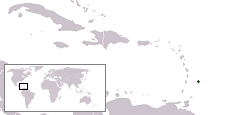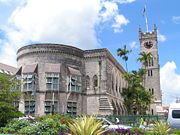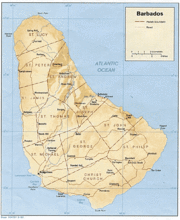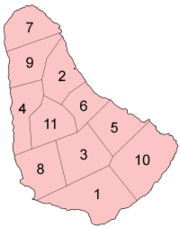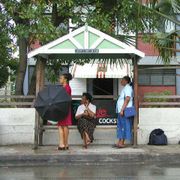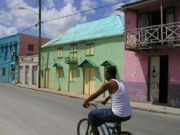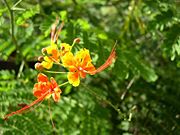Barbados
2008/9 Schools Wikipedia Selection. Related subjects: Americas; Countries
| Barbados | ||||||
|---|---|---|---|---|---|---|
|
||||||
| Motto: "Pride and Industry" | ||||||
| Anthem: In Plenty and In Time of Need |
||||||
|
|
||||||
| Capital (and largest city) |
Bridgetown |
|||||
| Official languages | English | |||||
| Recognised regional languages | Barbadian Dialect | |||||
| Ethnic groups | 90% Afro-Caribbean, 4% European, 6% Asian and Multiracial |
|||||
| Demonym | Barbadian (Official) Bajan (Slang) |
|||||
| Government | Parliamentary democracy and Constitutional monarchy | |||||
| - | Monarch | Elizabeth II | ||||
| - | Governor-General | Clifford Husbands | ||||
| - | Prime Minister | David Thompson | ||||
| Independence | From the United Kingdom | |||||
| - | Date | 30 November 1966 | ||||
| Area | ||||||
| - | Total | 431 km² ( 199th) 167 sq mi |
||||
| - | Water (%) | negligible | ||||
| Population | ||||||
| - | July 2006 estimate | 279,000 ( 174th) | ||||
| GDP ( PPP) | 2006 estimate | |||||
| - | Total | $4.9 billion ( 149th) | ||||
| - | Per capita | $17,610 ( 39th) | ||||
| HDI (2007) | ▲ 0.892 (high) ( 31st) | |||||
| Currency | Barbadian dollar ($) ( BBD) |
|||||
| Time zone | ( UTC-4) | |||||
| Internet TLD | .bb | |||||
| Calling code | +1 (246) | |||||
Barbados (Portuguese word for bearded-ones, pronounced /bɑrˈbeɪdoʊz, -dɒs/), situated just east of the Caribbean Sea, is an independent island nation in the western Atlantic Ocean. At roughly 13° North of the equator and 59° West of the prime meridian, the country lies in the southern Caribbean region, where it is considered a part of the Lesser Antilles. Its closest island neighbours are Saint Vincent & the Grenadines and Saint Lucia to the west. To the south lies Trinidad and Tobago—with which Barbados now shares a fixed official maritime boundary—and also the South American mainland. Barbados's total land area is about 430 square kilometres (166 square miles), and is primarily low-lying, with some higher regions in the country's interior. The highest point in Barbados is Mount Hillaby in the parish of Saint Andrew. The geological composition of Barbados is thought to be of non-volcanic origin and is predominantly composed of limestone- coral formed by subduction of the South American plate colliding with the Caribbean plate. The island's climate is tropical, with constant trade winds off the Atlantic Ocean serving to keep temperatures mild. Some less developed areas of the country contain tropical woodland and mangroves. Other parts of the interior which contribute to the agriculture industry are dotted with large sugarcane estates and wide, gently sloping pastures, with panoramic views down to the coast.
Barbados's human development index ranking is consistently among the top 50 in the world. For example, in 2006, it was ranked 31st in the world, and third in the Americas, behind Canada and the United States.
History
Etymology
According to accounts by descendants of the aboriginal Arawak tribes on other local islands, the original name for Barbados was Ichirouganaim.
The origin of the name "Barbados" is controversial. The Portuguese, en route to Brazil are credited as the first Europeans to discover and name the island. It is a matter of conjecture whether the word "bearded" refers to the long, hanging roots of the bearded fig-tree ( Ficus citrifolia), indigenous to the island, to bearded Caribs inhabiting the island, or to the foam spraying over the outlying reefs giving the impression of a beard. In 1519, a map produced by the Genoese mapmaker Vesconte de Maggiola showed and named Barbados in its correct position north of the island of Dominica.
Early history
The first indigenous people were Amerindians who arrived here from Venezuela around approximately 350-400 B.C. The Arawak people were the second wave of migrants, arriving from South America around 800. In the thirteenth century, the Caribs arrived from South America in the third wave, displacing both the Arawak and the Salodoid-Barrancoid . For the next few centuries, the Caribs — like the Arawak and the Salodoid-Barrancoid — lived in isolation on the island.
The Portuguese then briefly claimed Barbados from the mid 1500s to the 1600s; and may have seized the indigenous Caribs on Barbados and used them as slave labour. Other Caribs are believed to have fled the island to neighbouring islands. Apart from possibly displacing the Caribs, the Portuguese left little impact and by the 1610s, they left for South America leaving the island uninhabited.
British colonial rule
British sailors who landed on Barbados in 1625 arrived at the site of present-day Holetown. At the time it was inhabited only by the feral pigs descended from those left behind by the Portuguese. From the arrival of the first British settlers in 1627–1628 until independence in 1966, Barbados was under uninterrupted British control. Nevertheless, Barbados always enjoyed a large measure of local autonomy. Its House of Assembly began meeting in 1639. Among the initial important British figures was Sir William Courten.
With the increased implementation of slave codes, which created differential treatment between Africans and the white settlers, the island became increasingly unattractive to poor whites. Black or slave codes were implemented in 1661, 1676, 1682, and 1688. In response to these codes, several slave rebellions were attempted or planned during this time, but none succeeded. However, an increasingly repressive legal system caused the gap between the treatment of typically white indentured servants and black slaves to widen. Imported slaves became much more attractive for the rich planters who would increasingly dominate the island not only economically but also politically. Some have speculated that, because the Africans could withstand tropical diseases and the climate much better than the white slave population, the white population decreased. This is inconsistent with the fact that many poor whites simply migrated to neighbouring islands and remained in tropical climates. Nevertheless, as those poor whites who had or acquired the means to emigrate often did so, and with the increased importation of African slaves, Barbados turned from mainly Celtic in the seventeenth century to overwhelmingly black by the nineteenth century.
Barbados eventually had one of the world's biggest sugar industries after Jews from Brazil introduced the sugarcane to the island in the mid 1600s. This quickly replaced tobacco plantations on the islands which were previously the main export. As the sugar industry developed into its main commercial enterprise, Barbados was divided into large plantation estates that replaced the smallholdings of the early British settlers. Some of the displaced farmers moved to British colonies in North America, most notably North and South Carolina, Panama and British Guiana. To work the plantations, West Africans were transported and enslaved on Barbados and other Caribbean islands. The British abolished the slave trade in 1807. In 1816, the continuation of slavery caused the largest major slave rebellion in the island's history. 20,000 slaves from over seventy plantations rebelled. Whites were driven off of plantations, yet mass killings were avoided. Later termed “Bussa's Rebellion” after the slave ranger Bussa who with his assistants hated slavery, found the treatment of slaves on Barbados to be “intolerable,” and believed the political climate in the UK made the time ripe to peacefully negotiate with planters for freedom (Davis, p. 211, Northrup, p. 191). Brussa's Rebellion failed. One hundred and twenty died in combat or were immediately executed; another 144 were brought to trial and executed; remaining rebels were shipped off the island (Davis, pp. 212-213). Slavery was abolished in the British Empire eighteen years later in 1834. In Barbados and the rest of the British West Indian colonies, full emancipation from slavery was preceded by an apprenticeship period that lasted four years.
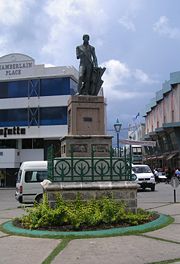
In 1884, the Barbados Agricultural Society sent a letter to Sir Francis Hincks requesting his private and public views on whether the Dominion of Canada would favourably entertain having the then colony of Barbados admitted as a member of the Canadian Confederation. Asked of Canada were the terms of the Canadian side to initiate discussions, and whether or not the island of Barbados could depend on the full influence of Canada in getting the change agreed to by the United Kingdom. Then in 1952 the Barbados Advocate newspaper polled several prominent Barbadian politicians, lawyers, businessmen, the Speaker of the Barbados House of Assembly and later as first President of the Senate, Sir Theodore Branker , Q.C. and found them to be in favour of immediate federation of Barbados along with the rest of the British Caribbean with complete Dominion Status within five years from the date of inauguration of the West Indies Federation with Canada.
However, plantation owners and merchants of British descent still dominated local politics, owing to the high income qualification required for voting. More than 70% of the population, many of them disenfranchised women, were excluded from the democratic process. It was not until the 1930s that the descendants of emancipated slaves began a movement for political rights. One of the leaders of this movement, Sir Grantley Adams, founded the Barbados Labour Party, then known as the Barbados Progressive League , in 1938. A staunch supporter of the monarchy, Adams and his party demanded more rights for the poor and for the people. Progress toward a more democratic government in Barbados was made in 1942, when the exclusive income qualification was lowered and women were given the right to vote. By 1949 governmental control was wrested from the planters and, in 1958, Adams became Premier of Barbados.
From 1958 to 1962, Barbados was one of the ten members of the West Indies Federation, an organisation doomed by nationalistic attitudes and by the fact that its members, as British colonies, held limited legislative power. Adams served as its first and only "Premier", but his leadership failed in attempts to form similar unions, and his continued defence of the monarchy was used by his opponents as evidence that he was no longer in touch with the needs of his country. Errol Walton Barrow, a fervent reformer, became the new people's advocate. Barrow had left the BLP and formed the Democratic Labour Party as a liberal alternative to Adams' conservative government. Barrow instituted many progressive social programmes, such as free education for all Barbadians, and the School Meals system. By 1961, Barrow had replaced Adams as Premier and the DLP controlled the government.
With the Federation dissolved, Barbados had reverted to its former status, that of a self-governing colony. The island negotiated its own independence at a constitutional conference with the United Kingdom in June 1966. After years of peaceful and democratic progress, Barbados finally became an independent state within the Commonwealth of Nations on November 30, 1966, with Errol Barrow its first Prime Minister.
Government and politics
Barbados has been an independent state in the Commonwealth since November 30, 1966. It functions as a constitutional monarchy and parliamentary democracy, modeled on the British Westminster system, with Elizabeth II, Queen of Barbados, as head of state and the Prime Minister as the head of the government. Its Parliament comprises thirty seats. It has been proposed that Barbados become a republic with a president replacing the Barbadian sovereign; this issue is still being debated, as the island has been stable and governmentally autonomous for decades.
Barbados is a full and participating member of the Caribbean Community (CARICOM), the Caribbean (CARICOM) Single Market and Economy (CSME), the Caribbean Court of Justice (CCJ), which pertains only to Barbados and Guyana but is expected to replace the UK Privy Council for the entire English-speaking Caribbean eventually, and the Association of Caribbean States (ACS).
Barbados has a two party system, the two dominant parties being the ruling Democratic Labour Party and the Barbados Labour Party. The Barbados Labour Party (BLP) had been in government for fifteen years, since 1993 until the 2008 general election. Under this administration, the Former Prime Minister, The Right Honourable Owen S. Arthur also acted as the Regional Leader of the CSM (Caribbean Single Market). The Right Honorable David Thompson is the Prime Minister of Barbados.
Geography
Barbados is a relatively flat island, rising gently to the central highland region, the highest point being Mount Hillaby, in the Scotland District , at 340 metres (1,100 ft) above sea level. The island is located in the Atlantic Ocean, to the east of the other Caribbean islands. The climate is tropical, with a rainy season from June to October.
Barbados is often spared the worst effects of the region's tropical storms and hurricanes during the rainy season as its far eastern location in the Atlantic Ocean puts it just outside the principal hurricane strike zone, and a hurricane hits about every 26 years.
In the parish of Saint Michael lies Barbados' capital and main city, Bridgetown. Locally Bridgetown is sometimes referred to as "The City", but the most common reference is simply "Town". Other towns scattered across the island include Holetown, in the parish of Saint James; Oistins, in the parish of Christ Church, and Speightstown, in the parish of Saint Peter.
It is geologically composed of coral (90 m/300 ft thick). The land falls in a series of "terraces" in the west and goes into an incline in the east. Most of Barbados is circled by coral reefs.
The climate is moderate tropical with two seasons; dry and wet. The dry season (Dec-May) and wet season (June- Nov) gives an annual rainfall of 40-90 inches (1,000–2,300 mm).
Parishes
Barbados is divided into eleven administrative parishes:
- Christ Church
- Saint Andrew
- Saint George
- Saint James
- Saint John
- Saint Joseph
- Saint Lucy
- Saint Michael ( The Saint Michael in is capital Bridgetown. )
- Saint Peter
- Saint Philip
- Saint Thomas
Economy
Historically, the economy of Barbados had been dependent on sugarcane cultivation and related activities, but in recent years it has diversified into the manufacturing and tourism sectors. Offshore finance and information services have become important foreign exchange earners, and there is a healthy light manufacturing sector. In recent years the Government has been seen as business-friendly and economically sound. Since the late 1990s the island has seen a construction boom, with the development and redevelopment of hotels, office complexes, and homes.
The government continues its efforts to reduce unemployment, encourage direct foreign investment, and privatize remaining state-owned enterprises. Unemployment has been reduced from around 14 percent in the past to under 10 percent.
The economy contracted in 2001 and 2002 due to slowdowns in tourism, consumer spending and the impact of the September 11, 2001 attacks, but rebounded in 2003 and has shown growth since 2004. Traditional trading partners include Canada, the Caribbean Community (especially Trinidad and Tobago), the United Kingdom and the United States.
Business links and investment flows have become substantial: as of 2003 the island saw from Canada C$25 billion in investment holdings, placing it as one of Canada's top five destinations for Canadian Foreign Direct Investment (FDI). Businessman Eugene Melnyk of Toronto, Canada, is said to be Barbados' richest permanent resident.
It is thought that the year 2006 will turn out to have been one of the busiest years for building construction ever in Barbados, as the building-boom on the island has entered a final stage for several multi-million dollar projects across the island..
Transport
Transport on the island is good, with 'route taxis', called "ZR's" (pronounced "Zed-Rs" not "Zee-Rs"), travelling to most points on the island. These small buses can at times be crowded, but will usually take the more scenic routes to destinations. They generally depart from the capital Bridgetown or from Speightstown in the northern part of the island.
The island of Barbados's lone airport is the Sir Grantley Adams International Airport (GAIA) ( IATA identifier BGI). It receives daily flights by several major airlines from points around the globe, as well as several smaller regional commercial airlines and charters. The airport serves as the main air-transportation hub for the Eastern Caribbean. It is undergoing a US$100 million upgrade and expansion.
There are three bus systems running seven days a week (though less frequently on Sundays), and a ride on any of them costs $1.50 BBD. The smaller buses from the two privately-owned systems ("ZRs" and "minibuses") can give change; the larger blue and yellow buses from the government-operated Barbados Transport Board system cannot. Most routes require a connection in Bridgetown. Some drivers within the competitive privately owned systems are reluctant to advise persons to use competing services, even if those would be more suitable.
Some hotels also provide visitors with shuttles to points of interest on the island from outside the hotel lobby. The island also has plenty of taxis for hire, though they can be expensive. Visitors also have the option of transport by car, presuming that they have a driver's licence (issued in their native country). There are several locally-owned and -operated vehicle rental agencies in Barbados but there are no multi-national car-rental agencies such as Avis, Europcar or Hertz.
There is also a helicopter shuttle service, which offers air taxi services to a number of sites around the island, mainly on the West Coast tourist belt. Air and water traffic is regulated by the Barbados Port Authority.
Tourist information
The island is well developed, and there are internationally-known hotels offering world-class accommodation. Time-shares are available, and many of the smaller local hotels and private villas which dot the island have space available if booked in advance. The southern and western coasts of Barbados are popular, with the calm light blue Atlantic Ocean and their fine white and pinkish sandy beaches. Along the island's east coast the Atlantic Ocean side are tumbling waves which are perfect for light surfing, but a little bit risky due to under-tow currents.
Shopping districts are popular in Barbados, with ample duty-free shopping. There is also a festive night-life in mainly tourist areas such as the Saint Lawrence Gap. Other attractions include wildlife reserves, jewellery stores, scuba diving, helicopter rides, golf, festivals (the largest being the annual crop over festival July/Aug), sightseeing, cave exploration, exotic drinks and fine clothes shopping.
Attractions, landmarks and points of interest
Tourism accounts for almost one half of the economy. Name / Parish Location:
|
- Christ Church
- St. Andrew
- St. George
|
- St. James
- St. John
- St. Joseph
|
- St. Lucy
- St. Michael
|
- St. Peter
- St. Philip
- St. Thomas
|
List of: Cities, towns and villages in Barbados.
- Bridgetown
- Speightstown
- Holetown
- Oistins
Demographics
Barbados has a population of about 279,000 and a population growth rate of 0.33% (Mid-2005 estimates). Close to 90 percent of all Barbadians (also known colloquially as Bajan) are of African descent ("Afro-Bajans"), mostly descendants of the slave labourers on the sugar plantations. The remainder of the population includes groups of Europeans ("Anglo-Bajans" / "Euro-Bajans") mainly from the United Kingdom, the Republic of Ireland, Chinese locally known as Bajan-Chiney, Bajan Hindus from India and Muslims from Bangladesh and Pakistan, and an influential "Arab-Bajans" group mainly of Christian Syrians and Lebanese descent. On the island are many people of Creole descent, a mixture of Afro-Caribbean and European descent (Primarily British, Irish and Portuguese).
Other groups in Barbados include people from the United Kingdom ( Barbadian Britons), United States and Canada. Barbadians who return after years of residence in the U.S. are called "Bajan Yankees"; this term is considered derogatory by some.
The country's official language is English, the local dialect of which is referred to as Bajan, spoken by most. In religion, most Barbadians are Protestant Christians (67%), chiefly of the Anglican Church, but there are other Protestant, Roman Catholic, Jehovah's Witness, Hindu, Muslim and Jewish minorities. Barbados is a chief destination for emigrants from the South American nation of Guyana. The biggest communities outside the Afro-Caribbean community are:
- The Indo-Guyanese, an important part of the economy due to the increase of immigrants from partner country Guyana. There are reports of a growing Indo-Bajan diaspora originating from Guyana and India. They introduced soca-chutney , roti and many Indian dishes to Barbados' culture. Mostly from southern India and Hindu states, these 'Desi' peoples are growing in size but smaller than the equivalent communities in Trinidad & Guyana; Hinduism is one of Barbados' growing religions.
- Euro-Bajans have settled in Barbados since the 1500s, originating from England, Portugal, Ireland and Scotland. More commonly they are known as " White Bajans", although some carry Afro-Caribbean traces and vice-versa. Euro-Bajans introduced folk music, such as Irish music and Highland music, and certain place names, such as "Scotland", a mountainous region, and "Trafalgar Square" in Bridgetown, now renamed "Heroes Square".
- Chinese-Barbadians (or, as they are known on the island, "Bajan-Chineys") are a small portion of Barbados' Asian demographics, smaller than the equivalent communities of Jamaica and Trinidad. Most if not all first arrived in the 1940s during the Second World War, originating mainly from the then British territory of Hong Kong. Many Chinese-Bajans have the surnames Chin, Chynn or Lee, although other surnames prevail in certain areas of the island. Chinese food and culture is becoming part of everyday Bajan culture.
- Lebanese and Syrians form the Middle Eastern community on the island and make up 89% of the Muslim population. Middle-Eastern Barbadians are often perceived to be the most successful group in business, along with the Chinese Bajans. During the Arab Israeli Wars, many Syrians and Lebanese headed for the West Indies to escape conflict and poverty in the Middle East. Also Jewish people arrived in Barbados around the same time, creating the biggest synagogue in the West Indies.
- Latin Americans have been migrating to the island since the 18th century, due to the close proximity, many Venezuelans had migrated to Barbados as labourers via Trinidad. Brazilian Jews, Colombians and Panamanians have also lived on the island. The Spanish language is now being encouraged to be taught in Barbadian schools over French.
Culture
The influence of the English on Barbados is more noticeable than on other islands in the West Indies. A good example of this is the island's national sport: cricket. Barbados has brought forth several great cricket players, including Garfield Sobers and Frank Worrell.
Citizens are officially called Barbadians; Barbados' residents, however, colloquially refer to themselves or the products of the country as "Bajan". The term "Bajan" may have come from a localized pronunciation of the word Barbadian which at times can sound more like "Bar-bajan".
The largest carnival-like cultural event which takes place on the island is the Crop Over festival. As in many other Caribbean and Latin American countries, Crop Over is an important event for many people on the island, as well as the thousands of tourists that flock to the island to participate in the annual events. The festival includes musical competitions and other traditional activities. It gets under way from the beginning of July, and ends with the costumed parade on Kadooment Day, held on the first Monday of August.
Barbados retains a strong British influence and is referred to by its neighbours as "Little England".
Another name associated with Barbados is "Bim" or "Bimshire". According to the National Cultural Foundation of Barbados, "Bim" was a word commonly used by slaves. It derives from the phrase "bi mu" from an Igbo phrase, meaning "my people." In colloquial or literary contexts, "Bim" can also take a more deific tone, referring to the "goddess" Barbados.
Sports in Barbados
As in other Caribbean countries of British descent, cricket is a favourite sport. In addition to several warm-up matches and six "Super Eight" matches, Barbados hosted the final of the 2007 Cricket World Cup.
In golf, the Barbados Open is an annual stop on the European Seniors Tour. In December 2006 the WGC-World Cup took place at the country's Sandy Lane resort on the Country Club course, an eighteen-hole course designed by Tom Fazio.
Motorsports also play a role, with Rally Barbados occurring each summer and currently being listed on the FIA NACAM calendar.
Netball is also popular with women in Barbados.
National symbols
Flower
The national flower is the Pride of Barbados or Caesalpinia pulcherrima (L.) Sw., which grows across the island.
Flag
The tridented centered within the flag is a representation of the mythological Neptune, god of the sea. The trident in its original unbroken form was taken from the former colonial seal, which itself was replaced by the current coat of arms. Used within the national flag, the left and right shafts of the trident were then designed as 'broken' representing the nation of Barbados breaking away from its historical and constitutional ties as a former colony.
The three points of the trident represent in Barbados the three principles of democracy - "government of, for and by the people." The broken trident is set in a centered vertical band of gold representing the sands of Barbados' beaches. The gold band itself is surrounded on both sides by vertical bands of ultramarine (blue) representing the sea and sky of Barbados.
The design for the flag was created by Grantley W. Prescod and was chosen from an open competition arranged by the Barbados government. Over a thousand entries were received.
Golden Shield
The Golden Shield in the coat of arms carries two " Pride of Barbados" flowers and the "bearded" fig tree ( Ficus citrifolia or Ficus barbata), which was common on the island at the time of its settlement by the British and may have contributed to Barbados being so named.
Coat of arms
The coat of arms depicts two animals which are supporting the shield. On the left is a " dolphin", symbolic of the fishing industry and sea-going past of Barbados. On the right is a pelican, symbolic of a small island named Pelican Island that once existed off the coast of Bridgetown. Above the shield is the helmet of Barbados with an extended arm clutching two sugar-cane stalks. The "cross" formation made by the cane stalks represents the saltire cross upon which Saint Andrew was crucified. On the base of the Coat of Arms reads "Pride and Industry" in reference to the country's motto.
International rankings
- - GDP - ( PPP) per capita:
- 2004: ranked 59 of 232 countries & territories -- $ 15,700 59th
- Economist, The, Worldwide quality-of-life index:
- 2005 ranked 33 out of 111 countries 33rd
- Heritage Foundation/The Wall Street Journal, Index of Economic Freedom countries:
- 2005 ranked 32 of 155 countries 32nd
- International Telecommunication Union, Digital Access Index (Top 10 in Americas):
- 2002: ranked 45 of 178 countries 45th
- Literacy rate, countries by literacy rate - by UNDP
- 2005: ranked 23rd of 177 countries -- 99.7%
- Reporters without borders:
- 2004: N/A
- Save the Children, State of the World's Mothers:
- 2004: N/A
- Transparency International, Corruption Perceptions Index:
- 2004: ranked 21 out of 146 countries surveyed 21st
- UN, Human Development Index (HDI):
- 2006: ranked 31st out of 177 countries 31st (3rd in the Americas, after Canada and the United States).
- 2005: ranked 30th out of 177 countries 30th
- 2004: ranked 29th out of 177 countries 29th
- 2003: ranked 27th out of 175 countries 27th
- 2002: ranked 31st out of 173 countries 31st
- 2001: ranked 31st out of 162 countries 31st
- 2000: ranked 30th out of 174 countries 30th
- 1999: ranked 29th out of 174 countries 29th
- 1998: N/A
- World Economic Forum, Global Competitiveness Report/Growth Competitiveness Index:
- 2006-2007: ranked 31st out of 125 countries 31st (Barbados' debut to the list)
- World Economic Forum, The Global Information Technology Report 2006-2007's " Networked Readiness Index":
- 2006-2007: ranked 40th out of 122 countries 40th (Barbados' debut to the list)
- World Bank:
- Total GDP per capita
- 2003 (World Bank): ranked 38 -- $ 15,712
- Total GDP (nominal)
- 2003: ranked 138 -- $ 2,628
- Total GDP per capita
This article contains material from the CIA World Factbook (2000 edition) which, as a US government publication, is in the public domain. This article contains material from the CIA World Factbook (2003 edition) which, as a US government publication, is in the public domain.


